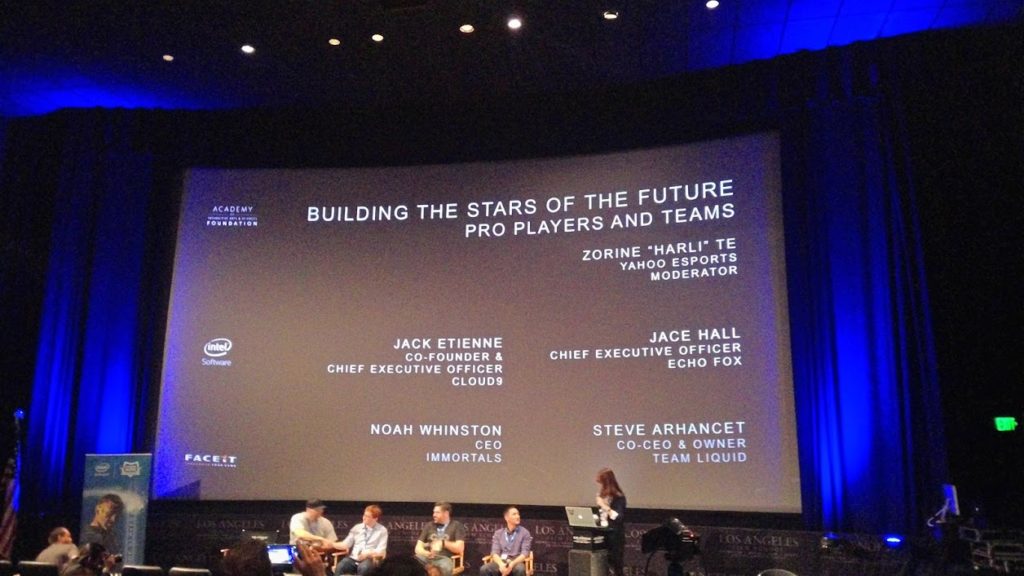One of the most engaging panels at the LA Intel Buzz Workshop on Wednesday featured the CEOs of four major esports organisations discussing their views on recruitment and player development.
Team Liquid’s Steve Arhancet, Cloud9’s Jack Etienne, Jace Hall of Echo Fox and Noah Whinston of Immortals began by discussing how early recruitment and training can start. Super League Gaming was brought up, the company which has in Steve’s words “adopted the softball model of membership for kids” recently announced it is moving into League of Legends thanks to a partnership with Riot.

Previously it has focused, with great success it should be added, on Minecraft. Arhancet stated how this addition is a big deal for recognising talent, and is a point which Noah Whinston echoed too.
One point which comes up time and again in discussions of esports players going pro is career length. Jack Etienne noted that “careers are getting longer and pro players are getting older” and the general assessment was that this is partly due to the overall esports landscape professionalising and it becoming a more legitimate career path beyond your early 20s.
This is a trend which should continue too, because as Jace Hall put it: “Longevity of player careers is connected to the evolution of the esports market as a whole”. Of course certain big titles lend themselves better to older players, for instance Dota more so than Starcraft but then with the latter’s fall from grace this will increasingly be a non-issue.
Whinston also made the point that whilst rosters stabilise further, this will benefit and expand career lengths too.
So you want to be an esports player? The question of how to be scouted is one on the minds of many and it’s tough. On the flip side however, doing the discovery successfully is one very much on the minds of team owners too and one it seems that is an equally tough cookie. Whinston made the fascinating point that in the past it cost in the region of $150,000 to $200,000 to train and create an LCS ready player, but to sign one from another team it was closer to $75,000. Changes in the transfer market however mean that these costs have leveled out far more. This should in turn mean that teams are more invested in discovering raw talent.
“It’s not an exact science and selecting players is much, much more than signing up those at the top of a leaderboard.”
Etienne said how it’s “not an exact science” and that it’s far more than seeing which player is top of the rankings. You need to talk to those that have played with them, ensure they can be a good fit for the team, ensure they have the right psychological aspects to handle the pressure of big events and play to the same standard live. Arhancet mentioned how Team Liquid were one of the first to introduce multiple teams in one title, and that this was done as a way of fostering and testing talent. He added that this is a far more expensive procedure than a few years ago.
Whinston also revealed how there is work being done to improve the statistical analysis of players to see it at the same level, or beyond, as those utilised in baseball and football.
The scouting differences between Korean organisations and North American orgs was then raised. This moved on to a discussion of the importance of esports and its mainstream acceptance in developing the best players. Hall stated how gamers are more revered and accepted socially in South Korea, and that it’s far more something to be proud of there. Whilst this is changing in North America, and to a lesser extent much of Europe too, it’s far from on par. Whinston added that the popularity of gaming PC cafes in the country, which many go to from a relatively young age, is a major factor too.
With the recent announcement of The Overwatch League, regional clubs was also a discussion point. Etienne spoke of his reluctance, or rather wariness, he said: “Cloud9 has global fans, so becoming Cloud9 Dallas for instance, could be detrimental in that it alienates some of these.”
“It’s up to the publishers to keep the game engaging and fresh.”
Attendees at the LA Film School event also got to listen to some of their views issues around game life span. Whinston stated that up until now a game’s life span has generally been around six to seven years, and pointed to Starcraft as evidence, but that “this doesn’t inherently mean this will continue to be the case.”
He continued: “It’s up to the publishers to keep the game engaging and fresh.”
Hall discussed that it’s up to teams and players to ensure they’re adaptable. He said: “It’s important for teams to work with players to develop a crossover skill-set. Are you a great LoL player or a great gamer? The latter is better for the overall esports landscape.”
He closed with the valid point that there needs to be more of a focus on the players than the titles and publishers, and that this is something they’re working on.
Esports Insider says: A great session with some valuable takeaways. Thanks to those on the panel, and FACEIT, Intel and AIAS Foundation for putting the event on.

